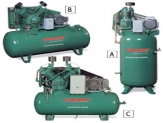 Air compressors have multiple functionality. In domestic use, they can be used to inflate basketballs, footballs and other sporting equipment, air mattresses and even automobile and bicycle tires.
Air compressors have multiple functionality. In domestic use, they can be used to inflate basketballs, footballs and other sporting equipment, air mattresses and even automobile and bicycle tires.
In industrial applications, compressed air can be used to operate machinery, for manufacturing operations, for cleaning, for eliminating pollutants from a confined workspace, and many other uses.
There are two major classes of industrial air compressors: Positive-displacement air compressors and dynamic air compressors.
How Air Compressors Work
A positive-displacement air compressor changes the volume of a chamber in order to compress air. Examples include a bicycle pump and a fireplace bellows. An external force is applied to reduce the volume of a chamber, and the resulting buildup of pressure compresses the air until it is eventually extracted.
An type used in industrial applications is the rotary positive-displacement air compressor. These usually come in two types: Helical screw compressors and sliding vane compressors.
A helical screw positive-displacement air compressor uses a helical screw to compress air between a meshing rotating motor and screw assembly. A sliding vane positive-displacement compressor uses a set of sliding vanes fitted into slots on a rotor eccentrically mounted in a cylindrical casing. As the rotor spins, centrifugal force pushes the vanes against the casing wall to compress air between the casing and the vanes.
A reciprocating air compressor utilizes a chamber that is composed of a piston inside of s cylinder. There are two types of reciprocating air compressors: single-acting and double acting.
In a single-acting reciprocating air compressor, only the face of the piston compresses the air inside the chamber. In double-acting reciprocating air compressor, both faces alternate in compressing the air within the chamber.
Dynamic Air Compressors and Their Uses
Dynamic air compressors work by compressing air velocity into air pressure using blades mounted on a rotating shaft. In centrifugal dynamic air compressors, air enters near the base of impeller blades, accelerates down the length of the blade then is expelled near the end of the blades at the circumference of the compressor case.
Another type of dynamic air compressor is the axial-flow compressor, in which air enters and exits along the axis of the shaft, normally by passing through several sets of rotor blades. Each set of rotating blades is spaced from the next via nonrotating stator blades. An example of an axial-flow compressor would be a jet engine on an aircraft.
Single- and Multi-Stage Air Compressors
Both dynamic air compressors and positive-displacement air compressors can be either single- or multi-stage. Single-stage compressors use only one air compression in the chamber. Multi-stage air compressors use two or more stages, building the output of one stage as the input to the next until they reach their final output pressure.
Which type of air compressor is used for specific industrial applications depends on its individual characteristics, including its flow, pressure, lubrication, and capacity control.
Bahrns features a wide variety of both positive-displacement and dynamic air compressors for industrial applications. With the many different types of air compressors to choose from, you are sure to find the right one for your specific needs.
